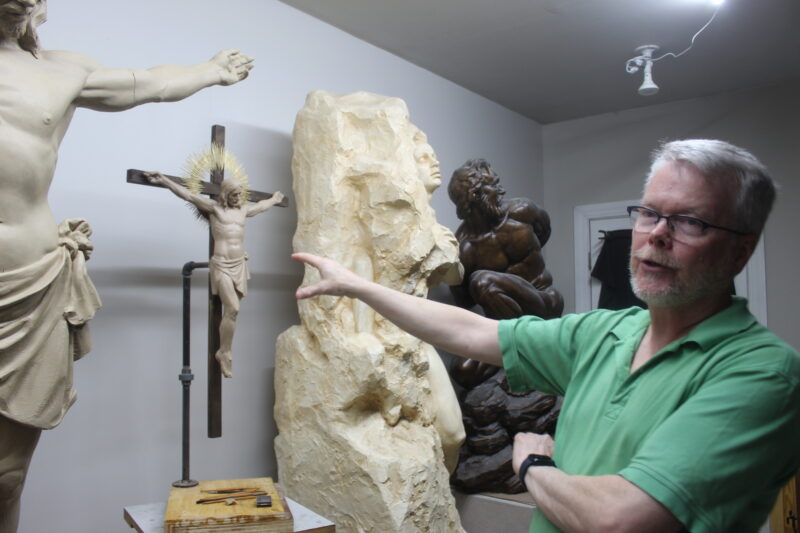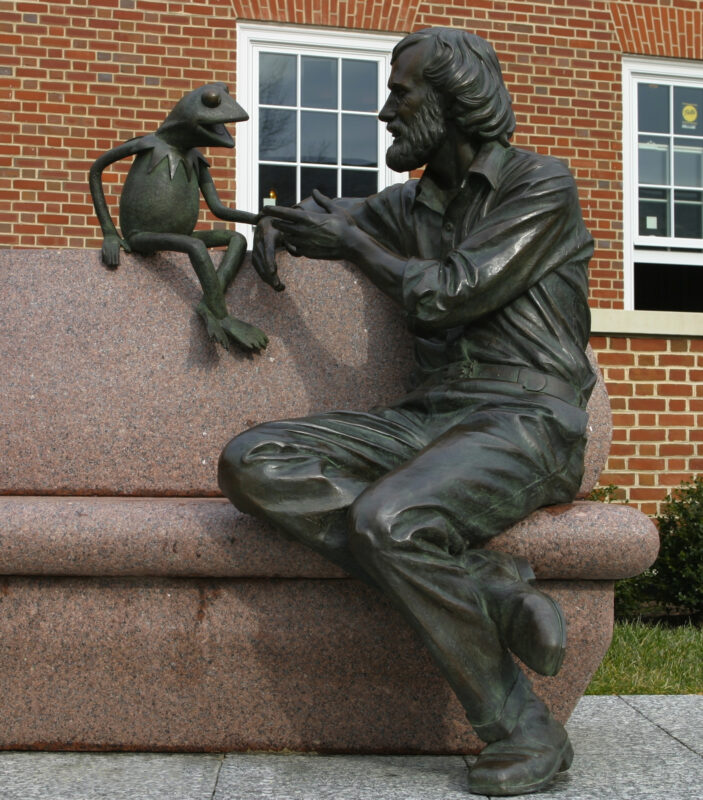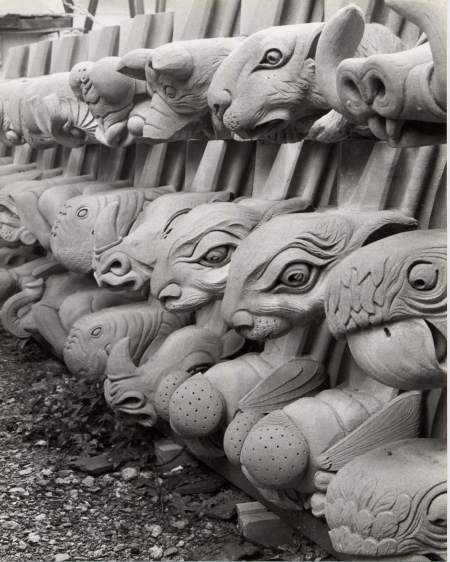Feats of clay
Carpenter brings sculpture skills from D.C. to Charlotte
Like so many days this summer, it was a rainy day. The kind of day we’re getting pretty used to around here.
After a drive up a steep and winding gravel road, it would be but a short dash from the car to Jay Carpenter’s home off Mt. Philo Road in East Charlotte. The wet weather is inconsequential to the waterlogged, which is what we all are.
You turn off the car.
And suddenly, Carpenter is there, all smiles and enthusiasm. Even if it wasn’t raining, Carpenter’s cup runneth over with politeness. He’s carrying two unfurled umbrellas.
You gave up umbrellas two months ago as just not worth the bother, so it’s a bit awkward remastering an umbrella, and not anything like riding a bicycle.

As a high school student in the 1970s, Jay Carpenter got a summer job. That summer job lasted almost 50 years. Carpenter retired from his job as sculptor-in-residence at the Washington National Cathedral a year ago when he and his family moved into his in-laws’ house off Mt. Philo Road.
Carpenter, his wife Susan McCullough and 15-year-old daughter Fiona, have been coming for holidays and vacations for almost 20 years, but decided they would join Tim McCullough to help out after his wife and Susan’s mother died.
Fiona is a student at Champlain Valley Union High and, if her dad has it right, she’s liking it. Susan McCullough is in development for nonprofits.
Carpenter had been fascinated and fantasizing about the National Cathedral since he was a young child from driving by with his parents. He would think, “Someday …” But he didn’t know what “someday” meant.
Although he spent a lot of his youth in art classes, it was hard for Carpenter to make the leap to seeing himself as an artist. And it was unthinkable to have an idea that one day he would be a sculptor at the Washington National Cathedral.
The National Cathedral had been under construction since1907. It was finished in 1990 after 83 years of construction. And you thought trying to get something built in Charlotte took time.
However, Carpenter ended up attending the St. Albans School, a college-prep school in Washington, D.C., on the grounds of the National Cathedral. At school, Carpenter had the opportunity to watch the stone carvers.

“They were carving gargoyles at the time and I was just absolutely enraptured,” he said.
When he was 17, he finally got up enough nerve to ask for a summer job, and he was hired. So, he was running errands, sweeping floors, building crates and the like, but he was working for the sculptors of the National Cathedral.
Although the only jobs Carpenter had had were sweeping floors and delivering newspapers, he began to push his way into the creative process.
“I made a clay model of a gargoyle and brought it in with trembling knees and showed it to the master carver. He liked it well enough to have it carved to put on the building,” Carpenter said.
It was the first sculpture Carpenter had ever made, and it was part of the National Cathedral. He would go on to do hundreds of sculptures there over the years.
In those days, Carpenter said there was a clear division between the sculptors and the carvers. For years there was a team of carvers working on statues but most of the time, Carpenter was the only person working in clay, or making maquettes. A maquette is a scale model often made of clay, wood or wax of a proposed statue’s design.
“I was the only sculptor, so it was an amazing, incredibly fortuitous job experience,” Carpenter said.
Before becoming a sculptor, he’d never dreamed of the possibility of actually being one. “It seemed kind of highfalutin,” he said.
He took a gap year off after high school and worked at the National Cathedral. They had an overload of work and he was happy to help. When he went to college, he worked summers and weekends.
Carpenter also became a sculptors assistant to Frederick Hart, famous for sculpting Ex Nihilo at the Washington National Cathedral and The Three Servicemen at the Vietnam Veterans Memorial.
After college he was a freelance sculptor working out of a studio off the grounds, but eventually he became the sculptor-in-residence with his own sculpting shed on the National Cathedral campus.
Carpenter loves living and working in Charlotte, but the move to paradise comes with tradeoffs. He leaves behind a studio filled with Northern light and 22-feet high ceilings.
A large basement is being converted into studios and an office. “It’s been an adjustment to be here and to try to set up a proper situation, but little by little we’ll get there,” he said.

The basement is already filled with fascinating people, probably looking much better than they did in life. Walls are lined with 7-foot likenesses that became statues of Frederick Douglas (courthouse Talbot County, Maryland); Douglas Fairbanks (atop a fountain at the University of Southern California’s film school); Bishop Baraga, the Snowshoe Priest, a missionary to the Native Americans in the Upper Peninsula (the Cathedral of St. Andrew in Grand Rapids, Mich.); Helen Claytor, who in 1967 became the first African American president of the YWCA; Katharine Drexel of Philadelphia, the patron saint of racial justice and of philanthropists, who was beatified as the second U.S.-born saint in 1988. It’s good they’re not speaking; it’s impossible to remember everybody’s name.
Since moving to Charlotte, Carpenter hasn’t noticed a slowdown in commissions, but he’d like to get more. And if the commissions were to slow down, he’s not worried. He’s got sketchbooks full of work he’d like to do.
He feels the profession of sculpture is at an exciting time. Technology has made a lot of changes, and most of those have been for the better. His specific field of figurative sculpture is also alive and dynamic. There are lots of opportunities for sculptors but there’s more competition.
When Carpenter first started there were fewer figurative sculptors because academic schools had shifted to abstract work.
“I was able to get some very good training, but it was hard to find, and there wasn’t much call for it,” he said. “Now, the training is very easy to find, and the call for it is plentiful.”
He is also a poet with a recently published book of 36 sonnets “Mount Fuji.” He’s written three other books of poetry, plays, musicals and children’s books. Carpenter said he is a poet because of things he can’t say through sculpting.
The two statues Carpenter are most proud of are the statue of Kermit and Jim Henson at the University of Maryland and the Revolutionary statute at the Leesburg Courthouse in Virginia. Carpenter’s statue depicts a farm family, walking into Leesburg — a mother, a son and the man who’s going to enlist in the militia. The statute “is on the very footprint of where the Declaration of Independence was read in Virginia for the first time,” Carpenter said.
